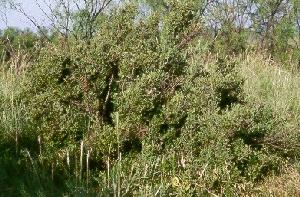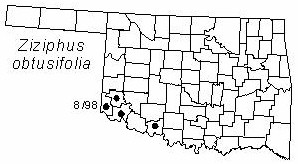
Spiny shrub to 2m (6 ft) in height. Bark light gray to brown, smooth. Twigs gray-green; with stout spines up to 7.5 cm (3 in) long. Leaves alternate, simple; elliptic, ovate or oblong, 1.2-3.2 cm (0.5-1.3 in) long; glabrous or lightly pubescent; cuneate at base, obtuse or acute at apex; margins entire to coarsely serrate; petioles short. Inflorescence an axillary cluster, pedicels 2 mm (1/12 in) long and villose, flowers are small and inconspicuous; sepals 5, triangular, acute, pubescent; petals 5, green, shorter than the sepals; styles 2-cleft; stamens 5; flowers appear in May. Fruits drupes, 10 mm (2/5 in) in diameter, globular, black; with single stone; fruits mature in June.
Distribution: Oklahoma and Texas, west to southern Arizona, south to northern Mexico. Uncommon in Oklahoma.
Habitat: rocky hillsides, primarily in the gypsum hills physiographic province.
Comments: Ziziphus is an ancient Greek name from the Persian word zizafun; obtusifolia refers to the obtuse apex of the leaf.
Food use: although edible, the fruits have little taste.
Medicinal use: Roots were used to treat wounds on domestic animals.
Economic uses: Roots were used as a soap substitute.
Wildlife benefits: Fruits are eaten by foxes, raccons and several species of birds.
NWI status: none
Distribution in Oklahoma: 
BACK
NEXT
RETURN TO INDEX
Last update: 9/23/99
 Go to Oklahoma Biological Survey Home Page
Go to Oklahoma Biological Survey Home Page
 Disclaimer
Disclaimer